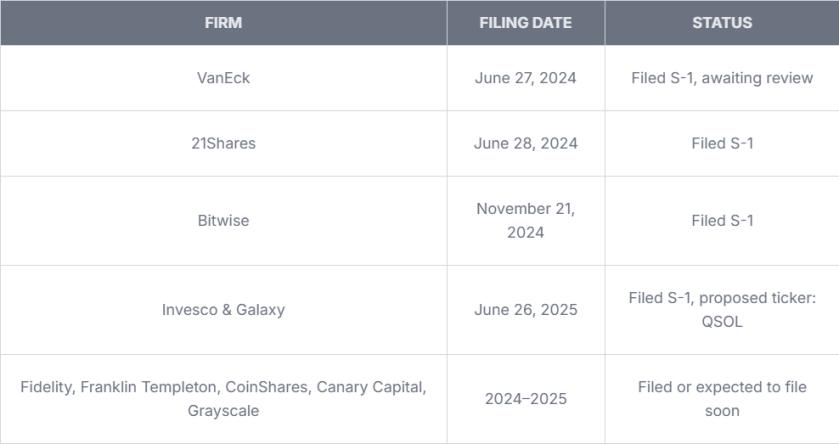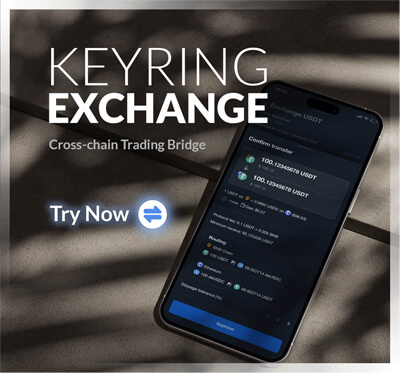Solana ETF: Everything You Need to Know and Why It Matters

As interest in crypto continues to grow, a new buzzword is making the rounds in financial circles: Solana ETF. Many investors, especially in the U.S., are hoping for a simple, regulated way to get exposure to Solana (SOL) — without the need to manage wallets, remember seed phrases, or worry about private keys.
So, what exactly is a Solana ETF? Why are so many financial firms racing to launch one? And what are the chances the U.S. SEC will approve it anytime soon?
Let’s break it all down in simple terms.
What Is a Solana ETF?
A Solana ETF (Exchange-Traded Fund) is a financial product that allows investors to gain exposure to the price of Solana (SOL) — without directly buying or managing the crypto themselves.
Think of it like this: Instead of buying SOL on a crypto exchange and storing it in a wallet, you buy shares of a fund that holds actual SOL tokens. These shares trade on the regular stock market, just like Apple or Tesla stock.
This kind of ETF is called a spot ETF, because it tracks the real-time (spot) price of the asset — in this case, Solana — by holding the asset directly.
Why is this a big deal?
- Easier for traditional investors: No need to learn how crypto wallets work.
- Regulated environment: ETFs are managed by licensed asset managers and regulated by the SEC.
- Transparent and secure: Investors get audited, legal exposure to crypto.
Top Solana NFT Marketplaces & How to Manage Your Portfolio with KEYRING NFT Viewer – KEYRING PRO
The Current State
No Solana Spot ETF (Yet) — But Many Are Coming
As of July 2025, there is no approved Solana Spot ETF in the United States. But that could change soon.
Over the past year, several big-name investment firms have submitted applications to the SEC to launch Solana ETFs. These include:

So far, the SEC has asked all issuers to amend their filings to include two key features:
- In-kind creation/redemption – The ETF must use real SOL tokens when creating or redeeming shares.
- Staking support – Since SOL offers staking rewards, the ETF must explain how staking will be handled.
The deadline for these revised filings is end of July 2025, and final decisions are expected around October 10, 2025. However, some analysts believe the SEC might approve some ETFs earlier — possibly by Q3 2025.
Solana Staking ETF
While we wait for a spot Solana ETF to be approved, another type of Solana-based fund has already launched — and it includes staking rewards.
On July 2, 2025, the REX-Osprey SOL + Staking ETF (ticker: SSK) started trading in the U.S. This fund gives investors two things:
- Exposure to the price of SOL
- A share of SOL staking rewards (like interest income)
- Tuy trên Solana ETF tracker trên trang the block showed it was a Spot ETF, but it’s not true, it is a staking ETF, there is no Solana Spot ETF at the moment
The SSK fund isn’t directly regulated by the SEC (it launched under a different legal framework), but that didn’t stop it from attracting serious money: over $74 million in assets just five days after launch.
Canada Made The First Move
Canada has already done what the U.S. hasn’t:
On April 16, 2025, Purpose Investments launched the world’s first Solana ETF — with integrated staking — on the Toronto Stock Exchange.

This gives Canadian investors regulated access to SOL, while Americans are still waiting for the SEC to make a move. It’s a repeat of history: Canada also beat the U.S. in launching Bitcoin and Ethereum ETFs.
How Is the Market Reacting?
The price of SOL has responded strongly to ETF news:
- After the June 2024 filings, SOL jumped 11%
- News of the SSK staking ETF led to a 5% daily gain
- Current SOL price (as of July 22, 2025): $202.13
- Market cap: $108.75 billion (#5 globally)
Even though daily fund flows into Solana ETFs range between – $15.7M and + $21M, that shows solid investor interest — especially for a product that hasn’t even been approved yet.
When is the Solana ETF Approval?
No one knows the exact day the SEC will finally greenlight a spot Solana ETF, but the winds are shifting. Here’s what’s different now:
In early July 2025, the SEC quietly requested issuers to amend and refile their applications before the end of the month, a sign they’re moving toward a decision. While the statutory deadline is October 10, 2025, the vibe among insiders is that the SEC doesn’t want another last-minute circus like with Bitcoin and Ethereum approvals.
Some are whispering about late August or September as the moment Solana might finally break through. The recent approval of the REX-Osprey Solana + Staking ETF, which launched on July 2 without the usual resistance, shows the SEC is already testing the waters with Solana-related products. This doesn’t guarantee a spot ETF will follow immediately, but it clears some regulatory fog.
Here’s the real talk:
-
If amended filings are clean, August–September is realistic.
-
If the SEC wants more time to tie up legal uncertainties, October 10 remains the final checkpoint.
-
If a black swan hits the crypto markets or Solana has another major outage, timelines could slip, but momentum suggests we’re closer to the finish line than ever before.
Bottom line: The approval isn’t about “if” anymore; it’s about how soon the SEC finishes checking boxes to let Solana ETFs run free, just as they did with Bitcoin and Ethereum. The market is watching late summer, but if it drifts, keep your eyes on October — the season Solana might finally go public in the ETF world.
![]()
(source: Solana ETF Tracker and Approval Status | The Block)
Why Is the SEC Taking So Long?
The U.S. Securities and Exchange Commission (SEC) is being extra cautious with crypto ETFs, especially those tied to altcoins like Solana.
Here’s what they’re worried about:
- Market manipulation: Can SOL’s price be easily manipulated on less-regulated crypto exchanges?
- Network centralization: Solana has a smaller group of validators compared to Ethereum or Bitcoin, raising concerns about how decentralized it really is.
- Technical reliability: Solana has experienced multiple network outages in the past, which could impact investor trust.
- Legal status: SOL has not been officially classified as a “commodity.” If it’s ruled to be a “security,” the SEC will have to apply stricter rules — or delay approval altogether.
Despite these concerns, there’s a positive sign:
In March 2025, the CME Group (Chicago Mercantile Exchange) launched Solana futures contracts, which are regulated financial products. The existence of futures trading on a major U.S. exchange has historically been a key factor in getting ETFs approved (as seen with Bitcoin and Ethereum).
Will the SEC Approve It?
Many experts think so. Bloomberg ETF analysts James Seyffart and Eric Balchunas now estimate 90–95% odds that the SEC will approve at least one Solana ETF in 2025.
Why?
- Futures are live on CME.
- A staking ETF already exists.
- The SEC has approved spot Bitcoin (Jan 2024) and spot Ethereum ETFs (July 2024).
- Political pressure and regulatory clarity are improving.
Also, the SEC tends to approve ETF applications in batches, as it did with Bitcoin and Ethereum. So, Solana ETFs could be approved together, sometime in late summer or early fall.

What’s the Big Deal If a Solana ETF Is Approved?
Here’s what a U.S.-approved Solana ETF could unlock:
- Easier Access for Everyone: Investors could buy SOL exposure through their normal brokerage accounts — no crypto exchanges needed.
- Mainstream Legitimacy: Approval would signal to institutions that Solana is a serious, investable asset.
- More Liquidity: Institutional capital could pour into SOL, improving trading volume and price stability.
- Price Growth Potential: Some analysts say SOL could hit $700 if a spot ETF is approved — depending on demand.
But There Are Still Risks
No investment is risk-free — especially in crypto. Here are a few things to keep in mind:
- Volatility: SOL is still a highly volatile asset, and an ETF won’t change that.
- Regulatory uncertainty: SOL might still be declared a security by the SEC.
- Fees: ETF management fees may reduce your returns, especially if you’re a long-term investor.
Final Thoughts: Should You Pay Attention?
Absolutely. A Solana ETF could be a big step toward bridging traditional finance and the crypto world.
It would:
- Let more investors get involved with SOL
- Bring credibility to Solana’s ecosystem
- Attract large-scale institutional money
But don’t rush in blindly. Crypto is still a risky space, and ETF approval is never guaranteed.
If you’re thinking about investing:
- Stay informed – Follow updates from Bloomberg, SEC, CoinDesk, and others.
- Know your risk tolerance – Crypto can be exciting, but it’s also unpredictable.
- Talk to a financial advisor – Especially if you’re not sure how to approach this new wave of crypto ETFs.

KEYRING PRO Wallet – Manage Your Assets Your Way
While ETFs like a potential Solana ETF make it easier for traditional investors to gain exposure to crypto, they aren’t the only way to participate in this growing ecosystem.
An ETF means you’re relying on a third party to hold and manage your assets. That’s fine for many, but some investors want more control, optionality, and direct access to their crypto while still maintaining simplicity.
This is where KEYRING PRO Wallet comes in.
KEYRING PRO Wallet allows you to hold, manage, and use your Solana (SOL) directly while still enjoying a smooth, secure experience. Unlike ETFs, where you only get price exposure, owning SOL in your wallet means you can:
-
Stake your SOL directly and earn rewards without middlemen.
-
Use your assets in DeFi if opportunities arise, instead of being locked into a passive ETF.
-
Retain full custody of your crypto while benefiting from advanced security and cross-chain capabilities.
For investors exploring Solana, combining a future Solana ETF (for easy, regulated exposure) with direct SOL ownership in KEYRING PRO Wallet (for control and on-chain participation) can offer the best of both worlds.
In short: ETFs can open the door, but wallets like KEYRING PRO ensure you still own your key, your crypto, and your freedom in this evolving market.
KEYRING PRO Wallet – Always ready.
KEYRING Gas Sponsorship Is a Game Changer and Here’s Why – KEYRING PRO


